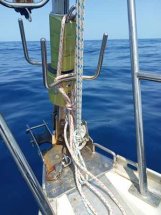The first 600 miles to Faial.

|
Bermuda-
Faial, at 18:30 on Saturday 20th, our position is 34:41.48N
051:59.06W and we are heading northeast. This leg has
been a roller coaster ride so far. We set off from Bermuda on Sunday
14th May with everything, we thought, in good shape; the weather was
fine and the forecast benign.
Leaving the island behind us I went below and noticed a strong smell of
diesel! There was diesel in the bilge and it
turned out, after emptying the cockpit locker (fenders, bikes, dinghy oars and
seats) to gain access, that the fuel tank breather pipe had split so the last
few liters of the fuel we added that morning in St Georges, had escaped into the
boat. I bailed diesel from the
bilges into a 10 litre can using the dinghy bailing scoop and did my best
with absorbent pads to wipe up the residue but the smell still lingers, and it
is difficult stuff to get rid of completely; there is a distinct hydrocarbon
smell when the gas rings are lit.
The nether regions of the bilges from the engine space to the under-cabin
soles are going to need a thorough scrub out during the winter layup.
That was
Sunday, on Monday morning we noticed the line to the furling drum was leading at
a strange angle and it turned out the furling drum bearing had come apart
allowing the drum and foil to slide up the wire forestay sufficiently for a
large amount of the new Dyneema furling line to be ‘welded’ around the stay
inside the bearing housing. At the
same time the sail was unfurling itself (and winding on more Dyneema) as the
wind was getting up. We had to get
the sail down before we could even assess the issue with the drum. This was a mouth-drying, monumental
struggle for Brian and me while Keith steered the boat with the sail thrashing
around our ears. Inch by inch we
hauled it down with nothing much to grip except folds of sail pulled bar tight
by the pressure of the wind. We had run off to try to shelter the sail behind
the main – and reduce the apparent wind –and, perhaps, going head to wind might
have been easier? It must have
taken forty minutes of work at the limit of my strength to get the sail on the
deck and eventually subdue its wild tendency to blow everywhere by lying on
it while recovering.
Then a second struggle to bundle it through the hatch to the sail bin
which it filled. We stopped for some breakfast and a rest and then set our very
small (No 4?) sail on the emergency forestay and carried on. The little sail was OK in the fresh wind
but would not pull like the Genoa in light airs. The following
day the wind went light to nothing and we motored and the flat sea gave us a
chance to examine the furling unit. I had also emailed Adrian at Eurospars in
Plymouth for advice, and he thought that the bearings and a retaining circlip
with the furling drum had failed, and we shouldn’t/couldn’t use it. This was a dilemma, we were 250 miles
from Bermuda and 1600 from Faial, should we go back to fix it, could it even be
fixed, or replaced, in Bermuda? We
erred on the side of continuing and explored options with the broken
furler. After a misguided attempt
to set the Genoa again (probably rash because we couldn’t reduce it in stronger
winds) we decided to remove the rope drum that carries the furling line and lash
the moving part of the furler to the forestay anchorage with several turns of
stout line. We then set a heavy
working jib on the foil with the understanding that we would have to lower it in
heavy weather. This sail came with
the boat, and I had never tried it; it was small but considerably bigger than
the No 4 but set very poorly. So poorly that even with the cars right forward,
we couldn’t sheet the sail properly and the head of the sail flogged in high
winds making a sound like rapid gun fire from the ranges at HMS Raleigh and made
the mast shake.
Nevertheless,
with a working jib we were up and, if not exactly running, off again and heading
for our next waypoint. Then the
gribs indicated a strong north-easterly weather system associated with a
high-pressure system near Canada. This was going to be wind on the nose, and we
opted to sail east to avoid the worst weather and enjoyed 36 hours of fast beam
reaching in fresh southerlies. It
almost worked, we eventually clipped the tail end of the weather system, but it
was weak enough by then to enable us to continue east, close-hauled. Then it
started to rain continuously, and visibility dropped to ½ mile at best. On top
of that waves hitting the side of the boat washed over the deck and into the
cockpit. The interior of the
boat became saturated, mostly water from wet foul weather gear on the watch
changes but clothing, upholstery and bedding all felt damp. Eventually, on the
evening of the 19th we emerged from the strong wind and rain zone,
exactly when the grip file said we should, and the weather started to
improve. The wind went light and
started to push us south until at 2:30 in the morning of the 20th,
Keith’s birthday, he made the decision on his watch to tack north. Since then,
the wind has come around sufficiently to allow us to sail NE towards our
destination but, with 7 knots of wind, we are only making 3-4 knots on a close
reach although, if the sea state continues to reduce, we may do better. The sun has come out, the boat is drying
out and the solar panels are charging the boat batteries – I had to use the
generator for a couple days in the claggy weather. I baked a ready-mix birthday cake during my 4-7am watch this morning and we had a birthday beer withnlunch in the cockpit. Over lunch we discussed the pros and cons of re-hoisting the Genoa in the foil to give us better speed in the light air. It is a lot of work to change sails and because we can’t roller reef, it would mean hauling it down and setting the working jib if the wind freshened which is a risk –and is going back to ‘old school’ foredeck work which I thought I had retired from. However, this afternoon’s gribs shows no wind over 10 knots for the foreseeable – and we are running out of milk! So tomorrow morning’s project is to change sails again. Where is all this easterly wind coming from? WEeare supposed to have westerlies at this lattitude. Hey ho, only 1100 miles to go.
|


